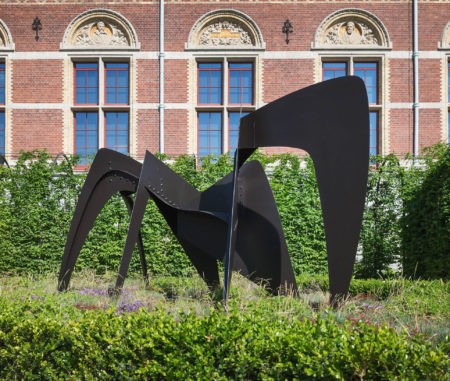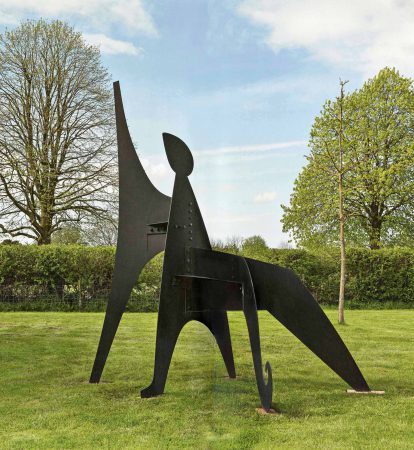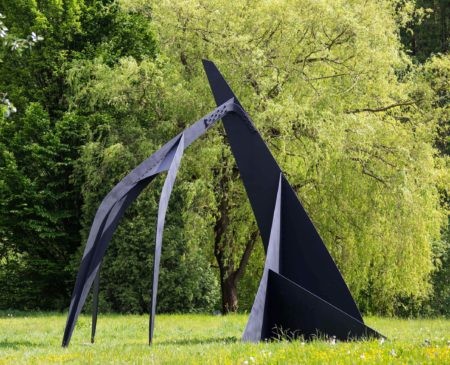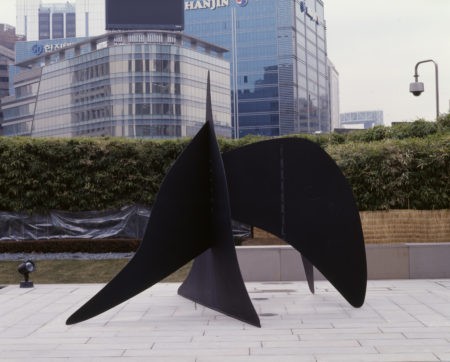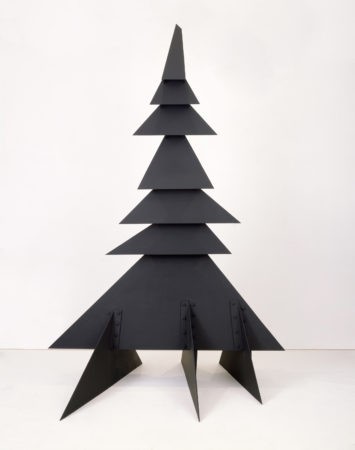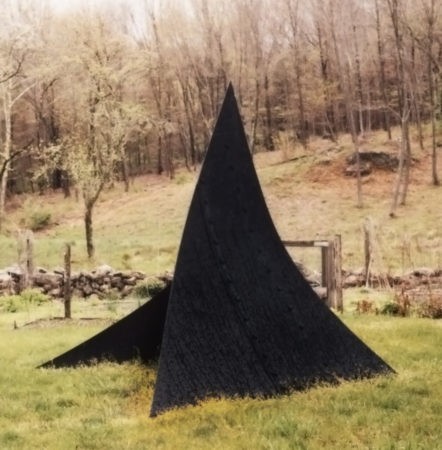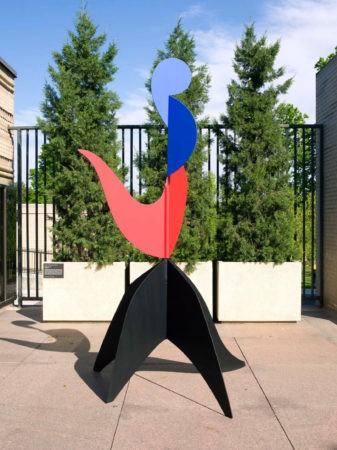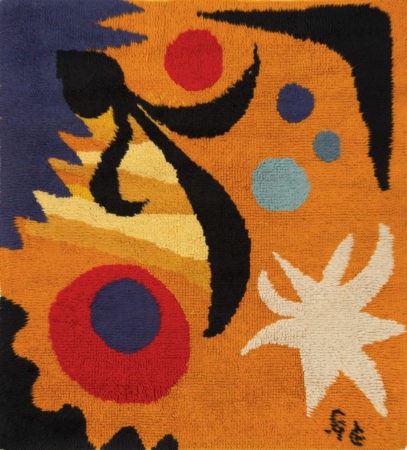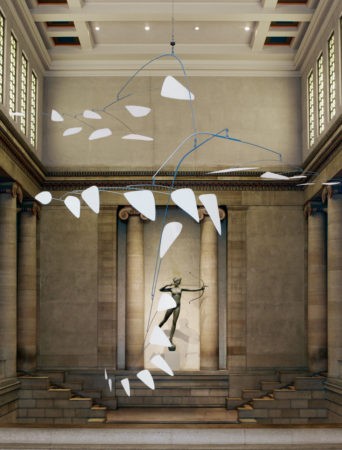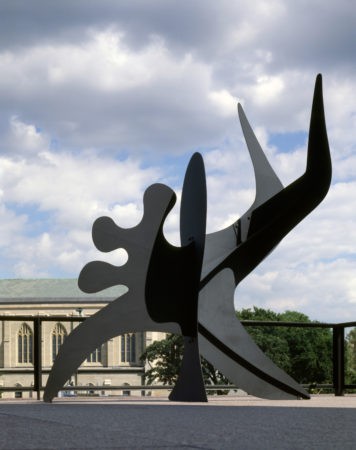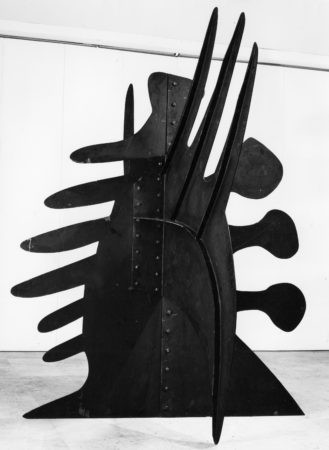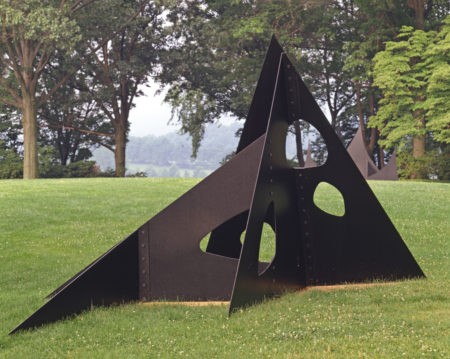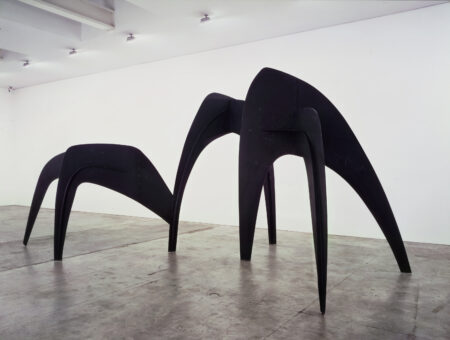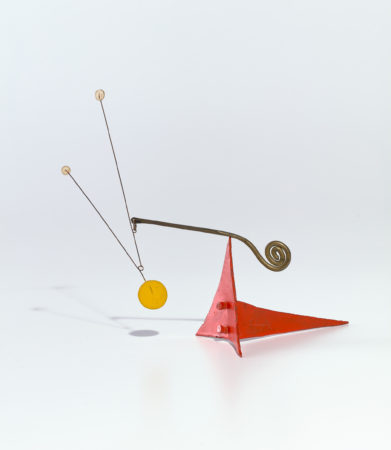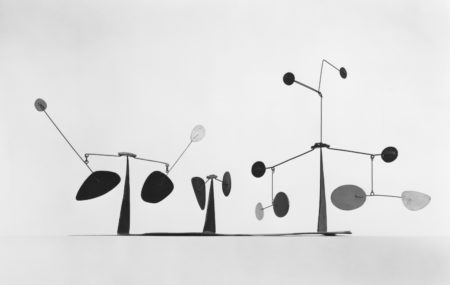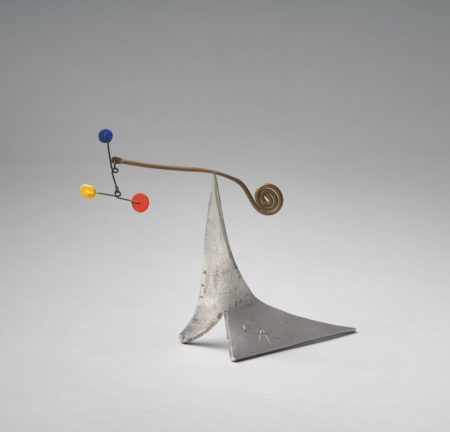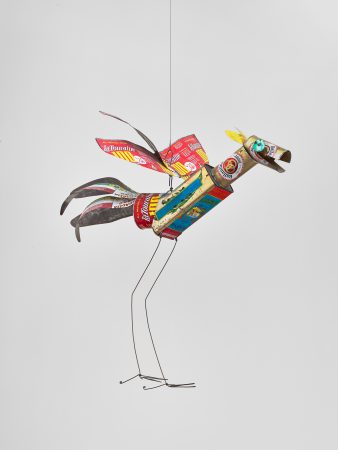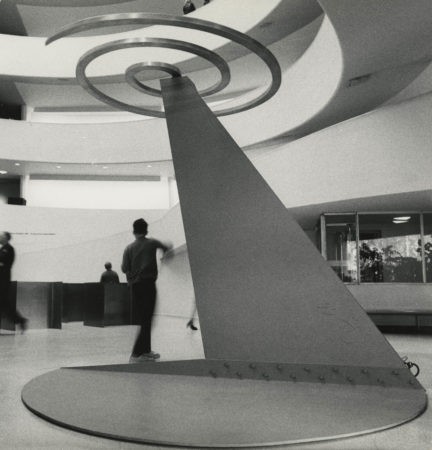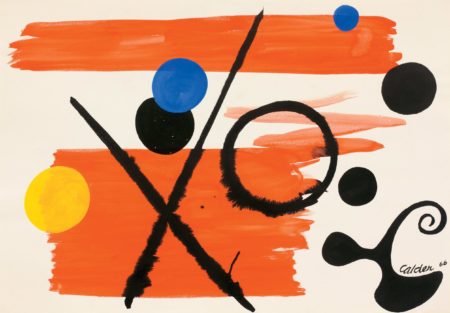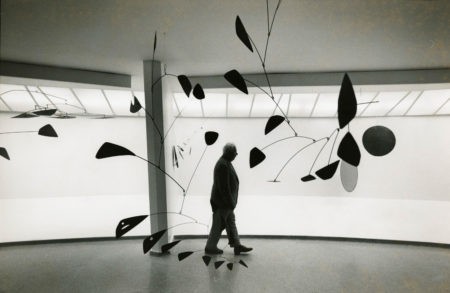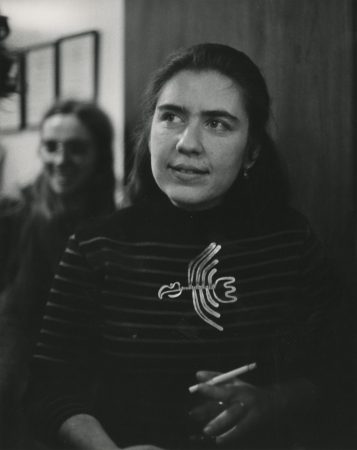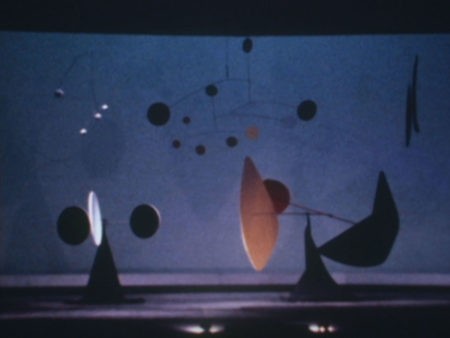Archive
See highlights from 1963–1976 on the timeline Monumental Works
Works
Exhibitions 247
1963
The Milk Train Doesn’t Stop Here Anymore (1963). Written by Tennessee Williams; mobile prop by Calder; directed by Herbert Machiz.
Theatrical PerformanceArt Institute of Chicago. 66th American Exhibition: Directions in Contemporary Painting and Sculpture. 11 January–10 February 1963.
Group ExhibitionFrank Perls Gallery, Beverly Hills. Calder: Mobiles, Stabiles and Gouaches. 13 March–12 April 1963.
Solo ExhibitionPerls Galleries, New York. Alexander Calder: 1963. 19 March–27 April 1963.
Solo ExhibitionGalerie Alex Vömel, Düsseldorf. Gouachen von Calder. May–June 1963.
Solo ExhibitionGalerie d’Art Moderne Marie-Suzanne Feigel, Basel. Arp/Calder/Marini. 11 May–30 September 1963.
Group ExhibitionWadsworth Atheneum, Hartford. 11 New England Sculptors. 18 July–15 September 1963.
Group ExhibitionPhiladelphia Museum of Art. Philadelphia Collects 20th Century. 3 October–17 November 1963.
Group ExhibitionMarlborough-Gerson Gallery, New York. Artists and Maecenas: A Tribute to Curt Valentin. November–December 1963.
Group ExhibitionGalerie Françoise Mayer, Brussels. 18 November 1963.
Solo ExhibitionGalerie Maeght, Paris. Alexander Calder: Stabiles. 22 November 1963.
Solo ExhibitionLa Provocation (1963). Choreographed by Pierre Halet; sets and costumes designed by Calder; music by Jean Ferrat; produced by Gabriel Monnet.
Theatrical Performance1964
Washington Gallery of Modern Art, Washington, D.C. Treasures of 20th Century Art from The Maremont Collection. 1 April–3 May 1964.
Group ExhibitionGalleria del Naviglio, Milan. Alexander Calder: Gouaches 1963–1964. 25 May–5 June 1964.
Solo ExhibitionAlte Galerie, Kassel, Germany. Documenta III: Malerei und Skulptur. 27 June–5 October 1964.
Group ExhibitionGalleria Cavallino, Venice. Alexander Calder: Gouaches 1963–64. 13–31 July 1964. Originated from the Galleria del Naviglio, Milan.
Solo ExhibitionPerls Galleries, New York. Calder: Circus Ink Drawings 1931–1932. 13 October–14 November 1964.
Solo ExhibitionGrosvenor Gallery, London. Miró: Graphics, Calder: Mobiles, Ch’i Pai-shih: Paintings. 28 October–20 November 1964.
Group ExhibitionSolomon R. Guggenheim Museum, New York. Alexander Calder: A Retrospective Exhibition. 6 November 1964–31 January 1965.
Solo ExhibitionThe Museum of Fine Arts, Houston. Alexander Calder: Circus Drawings, Wire Sculpture and Toys. 24 November–13 December 1964.
Solo ExhibitionTate Gallery, London. The Peggy Guggenheim Collection. 31 December 1964–7 February 1965.
Group Exhibition1965
Makler Gallery, Philadelphia. January 1965.
Solo ExhibitionEppur Si Muove (1965). Choreographed by Joseph Lazzini; sets designed by Calder; music by Francis Miroglio.
Theatrical PerformanceWashington University Art Gallery, St. Louis. Alexander Calder: A Retrospective Exhibition. 21 February–26 March 1965. Originated from the Solomon R. Guggenheim Museum, New York.
Solo ExhibitionMilwaukee Art Center, Wisconsin. Alexander Calder: A Retrospective Exhibition. 25 February–28 March 1965. Originated from the Solomon R. Guggenheim Museum, New York.
Solo ExhibitionDes Moines Art Center, Iowa. Alexander Calder: A Retrospective Exhibition. 28 April–30 May 1965. Originated from the Solomon R. Guggenheim Museum, New York.
Solo ExhibitionArt Gallery of Toronto. Mobiles and Stabiles by Calder, the Man Who Made Sculpture Move. 1–30 May 1965. Originated from the Solomon R. Guggenheim Museum, New York.
Solo ExhibitionBrook Street Gallery, London. Vasarely / Calder. July–September 1965.
Group ExhibitionMusée National d’Art Moderne, Paris. Calder. 8 July–15 October 1965. Originated from the Solomon R. Guggenheim Museum, New York.
Solo ExhibitionThe Museum of Modern Art, New York. Recent Acquisitions: Kay Sage Tanguy Bequest. 9 September–14 December 1965.
Group ExhibitionCharles E. Slatkin Galleries, New York. Contemporary French Tapestries. 20 September–20 October 1965.
Group ExhibitionMuseum of Contemporary Crafts, New York. The Art of Personal Adornment. 24 September–7 November 1965.
Group ExhibitionLaing Galleries, Toronto. 12 Calder Gouaches. 25 September–16 October 1965.
Solo ExhibitionLincoln Center Plaza, New York. Le Guichet. 15 November 1965.
Installation / Dedication Ceremony1966
Perls Galleries, New York. Alexander Calder–Recent Gouaches, Mobiles, Stabiles. 8 February–12 March 1966.
Solo ExhibitionGalerie Maeght, Paris. Calder: Gouaches et Totems. 18 February 1966.
Solo ExhibitionHayden Library, Massachusetts Institute of Technology, Cambridge. April 1966.
Solo ExhibitionRichard Gray Gallery, Chicago. Alexander Calder. 29 April–29 May 1966.
Solo ExhibitionUnited States Mission, United Nations, New York. Object in Five Planes. c. May 1966.
Installation / Dedication CeremonyMassachusetts Institute of Technology, Cambridge. May 1966.
Solo ExhibitionMcDermott Court, Massachusetts Institute of Technology, Cambridge. La Grande voile. 7 May 1966.
Installation / Dedication CeremonyGalerie Jan Krugier & Cie, Geneva. Alexander Calder. 9 June–30 July 1966.
Solo ExhibitionHarvard University, Cambridge, Massachusetts. Honorary Doctorate of Arts. 16 June 1966.
Award CeremonyBerkshire Museum, Pittsfield, Massachusetts. Mobiles by Alexander Calder. 2–31 July 1966.
Solo ExhibitionInstitute of Contemporary Arts, London. Calder–The Painter. 29 September–29 October 1966.
Solo ExhibitionFirst City National Bank, Houston. Five Sculptors. 3–28 October 1966.
Group ExhibitionJames Goodman Gallery, Buffalo, New York. Calder. 8–29 October 1966.
Solo ExhibitionCentre Culturel Municipal de Toulouse, France. Calder (Le Mois USA). 26 October–28 November 1966.
Solo ExhibitionDonald Morris Gallery, Detroit. Alexander Calder. 13 November–10 December 1966. Originated from the James Goodman Gallery, Buffalo, New York.
Solo ExhibitionPerls Galleries, New York. Calder: Jewelry. 15 November–17 December 1966.
Solo ExhibitionGalerie Françoise Mayer, Brussels. Totems, mobiles et gouaches récentes. 19 November–17 December 1966.
Solo Exhibition1967
Obelisk Gallery, Boston. Alexander Calder: Gouaches, Mobiles. 17 January–4 February 1967.
Solo ExhibitionThe Museum of Modern Art, New York. Calder: 19 Gifts from the Artist. 1 February–5 April 1967.
Solo ExhibitionOpenluchtmuseum voor beeldhouwkunst Middelheim, Antwerp. Totems et Gouaches. 10 February–5 March 1967.
Solo ExhibitionCalder Piece (1967). Written by Earle Brown; Chef d’orchestre conducting instrument by Calder; music commissioned and performed by Diego Masson and his orchestra. Performed at Théâtre de l’Atelier, Paris.
Theatrical PerformanceThe Phillips Collection, Washington, D.C. Recent Stabiles by Alexander Calder. 8 April–30 May 1967.
Solo ExhibitionArco d’Alibert, Studio d’Arte, Rome. Calder. 21 April–28 May 1967.
Solo ExhibitionUniversal and International Exposition (Expo ’67), Montreal. Man. 28 April–27 October 1967.
Installation / Dedication CeremonyAkademie der Künste, Berlin. Alexander Calder. 21 May–16 July 1967.
Solo ExhibitionHeath Gallery, Inc., Atlanta. Alexander Calder: Gouaches, Mobiles, Stabiles. 8 June 1967.
Solo ExhibitionMuseo d’Arte Moderno, Havana, Cuba. Salon de Mayo. July 1967.
Group ExhibitionEdgardo Acosta Gallery, Ltd., Beverly Hills. Twenty Gouaches by Calder: Dating from 1950 through June 1967, in Honor of his Sixty-Ninth Birthday. 15 August–7 September 1967.
Solo ExhibitionNew York Cultural Showcase Festival, New York. Sculpture in Environment. 1–31 October 1967.
Group ExhibitionPerls Galleries, New York. Calder: Early Work–Rediscovered. 14 November–23 December 1967.
Solo ExhibitionMartha Jackson Gallery, New York. Treasures from Inventory II: A Christmas Show of Small Works for Collectors. 21 November–23 December 1967.
Group Exhibition1968
Aztec Stadium, Mexico City. El Sol Rojo. 1968.
Installation / Dedication CeremonyWork in Progress (1968). Ballet originated by Calder; sets and costumes designed by Calder; electronic music by Niccolò Castiglioni, Aldo Clementi, and Bruno Maderna. Performed at Teatro dell’Opera, Rome.
Theatrical PerformanceMaison de la Culture, Bourges, France. Calder: Mobiles, Stabiles, Sculptures, Gouaches. 9 March–13 May 1968.
Solo ExhibitionDayton’s Gallery 12, Minneapolis. Calder. 17 April–11 May 1968.
Solo ExhibitionGraphisches Kabinett Karl Vonderbank, Frankfurt. Graphik von Appel, Calder, Dubuffet, Grieshaber, Schulze, Zadkin u.a. June 1968.
Group ExhibitionKiko Galleries, Houston. Calder. Fall 1968.
Solo ExhibitionMusée des Augustins, Toulouse, France. Calder: Mobiles, Stabiles, Sculptures, Gouaches. September 1968. Originated from Maison de la Culture, Bourges, France.
Solo ExhibitionGalerie Maeght, Paris. Flèches. 10 October–November 1968.
Solo ExhibitionPerls Galleries, New York. Calder / Space: Drawings 1930–1932; Gouaches 1967–1968. 15 October–9 November 1968.
Solo ExhibitionThe Museum of Modern Art, New York. The Machine as Seen at the End of the Mechanical Age. 25 November 1968–9 February 1969.
Group Exhibition1969
Donald Morris Gallery, Detroit. Calder Gouaches. 14 January–1 February 1969.
Solo ExhibitionSolomon R. Guggenheim Museum, New York. Works from the Peggy Guggenheim Foundation. 15 January–23 March 1969.
Group ExhibitionGimpel Fils, London. Alexander Calder: Standing Mobiles, 1968. 18 February–15 March 1969.
Solo ExhibitionAteneumin Taidemuseo, Helsinki. Ars 69 Helsinki. 8 March–13 April 1969.
Group ExhibitionFondation Maeght, Saint-Paul-de-Vence, France. Calder. 2 April–31 May 1969.
Solo ExhibitionManitou Gallery, Grand Valley State College, Allendale, Michigan. Calder. 4 May–15 June 1969.
Solo ExhibitionGrand Rapids Art Museum, Michigan. Alexander Calder: Mobiles and Stabiles. 18 May–24 August 1969.
Solo ExhibitionNational Museum of American Art, Smithsonian Institution, Washington, D.C. Gwenfritz. 3 June 1969.
Installation / Dedication CeremonyGrand Valley State College, Allendale, Michigan. Honorary Doctorate of Arts. 7 June 1969.
Award CeremonyVandenberg Center, Grand Rapids, Michigan. La Grande vitesse. 14 June 1969.
Installation / Dedication CeremonyLouisiana Museum of Modern Art, Humlebaek, Denmark. Calder. 29 June–7 September 1969. Originated from Fondation Maeght, Saint-Paul-de-Vence, France.
Solo ExhibitionFundación Eugenio Mendoza, Caracas, Venezuela. Calder en Venezuela. 6 July–3 August 1969.
Solo ExhibitionStedelijk Museum, Amsterdam. Calder. 4 October–16 November 1969. Originated from Fondation Maeght, Saint-Paul-de-Vence, France.
Solo ExhibitionPerls Galleries, New York. Alexander Calder: Bronze Sculptures of 1944. 7 October–8 November 1969.
Solo ExhibitionMétaboles (1969). Choreographed by Joseph Lazzini; set designed by Calder; music by Henri Dutilleux; produced by Théâtre Francais de la Danse. Performed at Odéon Theater, Paris.
Theatrical PerformanceThe Museum of Modern Art, New York. A Salute to Alexander Calder. 22 December 1969–15 February 1970.
Solo Exhibition1970
Galerie Blanche, Stockholm. Alexander Calder: Mobiler, Stabile-Mobiler, Gouacher 1961–1970. 1970.
Solo ExhibitionLong Beach Museum of Art, California. Calder Gouaches: The Art of Alexander Calder. 11 January–8 February 1970.
Solo ExhibitionHokin Gallery, Palm Beach, Florida. 15 January–7 February 1970.
Solo ExhibitionKovler Gallery, Chicago. Calder. 22 January–21 March 1970.
Solo ExhibitionFine Arts Gallery of San Diego, California. Calder Gouaches: The Art of Alexander Calder. 27 February–29 March 1970. Originated from the Long Beach Museum of Art, California.
Solo ExhibitionPhoenix Art Museum, Arizona. Calder Gouaches: The Art of Alexander Calder. 1–31 May 1970. Originated from the Long Beach Museum of Art, California.
Solo ExhibitionWhitney Museum of American Art, New York. Recent Acquisitions. 9 June–19 July 1970.
Group ExhibitionChateau de Ratilly, Nièvre, France. Calder / Bazaine. 19 June–10 September 1970.
Group ExhibitionGalerie Vömel, Düsseldorf. Calder. 1 July–31 August 1970.
Solo ExhibitionHistorical Photos 148
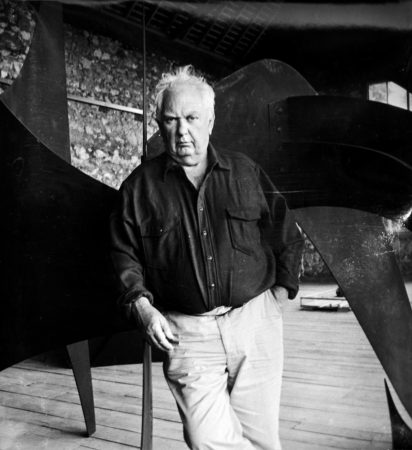







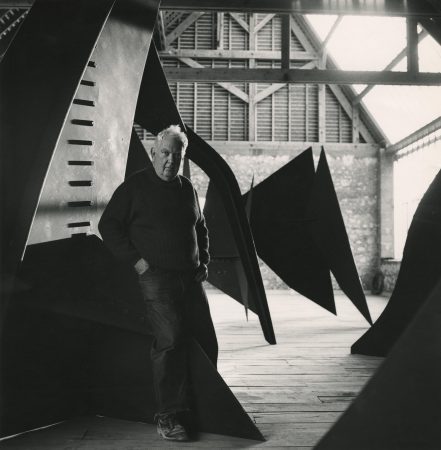
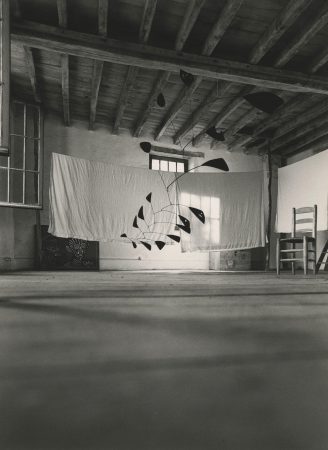
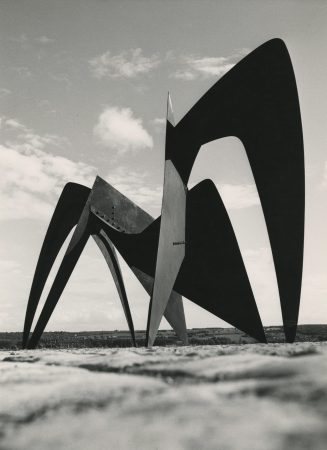
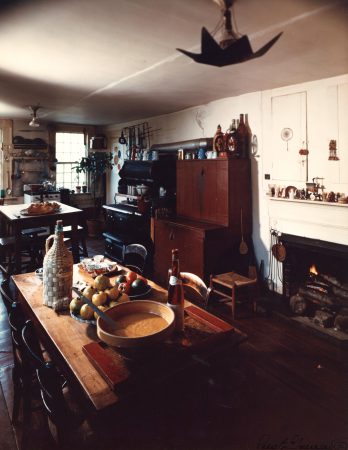
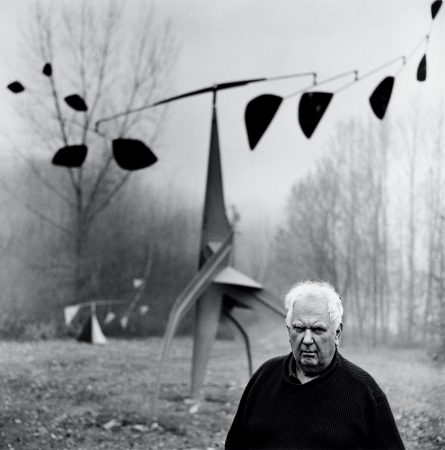
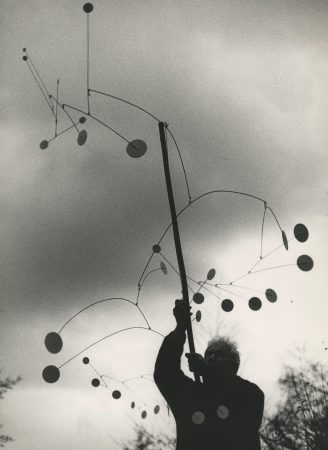

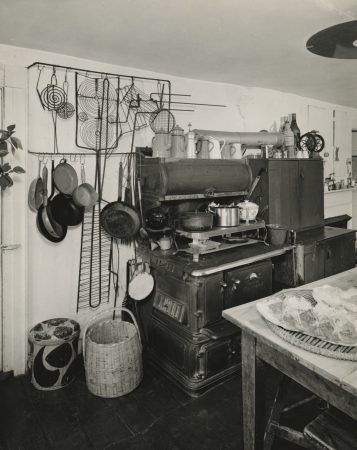



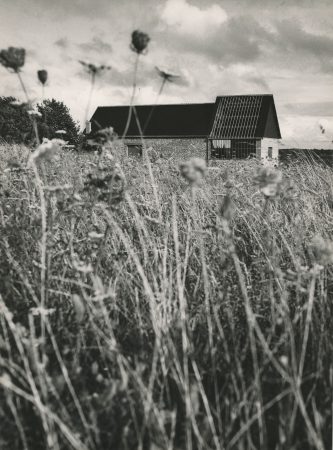

















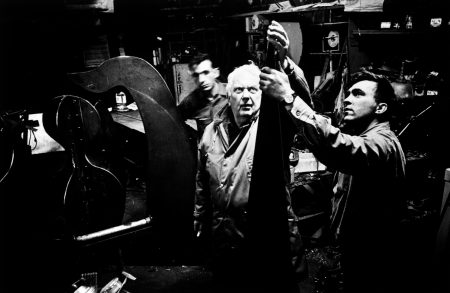




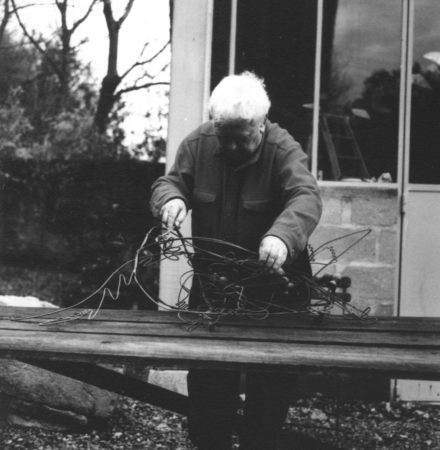




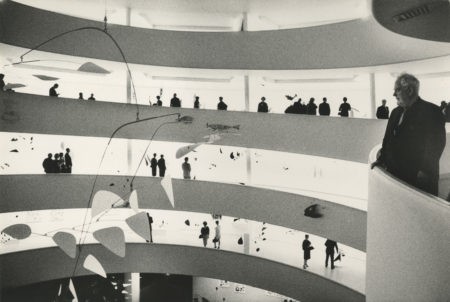
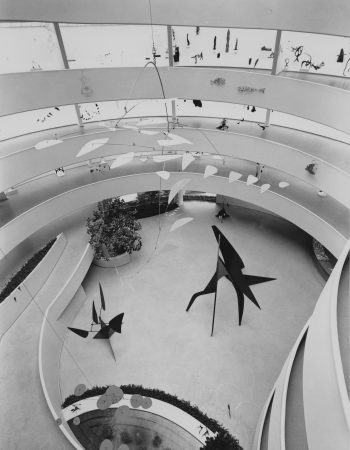









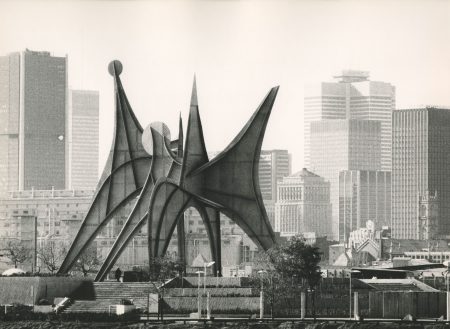
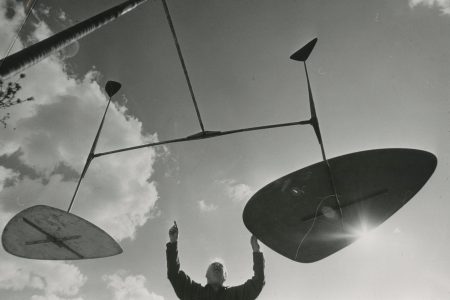








Calder with Le Faucon (1963), Les Trois ailes (1963), and Triangles and Arches (1965) outside the Le Carroi studio, Saché, 1967
Photograph by Tony Vaccaro / Tony Vaccaro ArchivesCalder with Le Faucon (1963), Les Trois ailes (1963), and Triangles and Arches (1965) outside the Le Carroi studio, Saché, 1967








Chronology 198
Hans Richter directs and films Alexander Calder: From the Circus to the Moon.
CF, project fileDiego Masson commissions Earle Brown to compose a piece of music for the Percussion Quartet of Paris. The two men travel to Saché to meet with Calder, and Brown begins to work on the score, which he titles Calder Piece.
CF, project fileCalder leaves Roxbury and flies to France to oversee work on six large stabiles at Etablissements Biémont.
Calder 1966, 265Calder returns to the United States.
CF, passportFrank Perls Gallery, Beverly Hills, exhibits “Calder: Mobiles, Stabiles and Gouaches.”
CF, exhibition filePerls Galleries, New York, exhibits “Alexander Calder: 1963.”
CF, exhibition fileThe Calders’ grandson, Alexander S. C. Rower, is born in New York to Mary and Howard Rower.
CF, birth certificateThe Calders return to France.
CF, passportCalder is awarded the Edward MacDowell Medal. Art historian Meyer Schapiro, the speaker at the Medal Day ceremony in New Hampshire, receives the medal on Calder’s behalf.
After eighteen months, the new studio at Le Carroi is completed.
Calder 1966, 264
Galerie Maeght, Paris, exhibits “Alexander Calder: Stabiles.” Catalogue essays include “L’ombre de l’avenir” by James Jones and “Qu’est-ce qu’un Calder?” by Michel Ragon, with cover and illustrations by Calder.
CF, exhibition fileLa Comédie de Bourges performs La Provocation, with sets and costumes designed by Calder and choreography by Pierre Halet. The play opens in Bourges and is performed the following year in Tours (10 May 1964) and Paris (4 November 1964).
CF, project file1964
Art in America and Perls Galleries publishes Calder’s Circus, a portfolio of sixteen unbound lithographs with a text by Cleve Gray and a reproduction of a letter from Miró describing Calder’s 1932 performance of Cirque in Montroig.
CF, object fileCalder completes the monumental standing mobile Chef d’orchestre for Earle Brown’s Calder Piece. The mobile functions as both a “conductor,” determining the sequence and speed of the music, and as one of the instruments whereupon the elements are struck or “played.”
CF, project fileThe Calders spend two weeks in Morocco; they visit Marrakech, Fès, Ouarzazate, and Casablanca.
AAA, Calder to Gray, 2 FebruaryThe Calders sail on the SS France for New York, departing from Le Havre.
CF, passport; AAA, Calder to Gray, 5 MayThe Calders arrive in New York on the SS France and travel to Roxbury.
CF, passportPerls Galleries, New York, exhibits “Calder: Circus Ink Drawings 1931–1932.”
CF, exhibition fileGrosvenor Gallery, London, presents “Miró: Graphics, Calder: Mobiles, Ch’i Pai-shih: Paintings.”
CF, exhibition fileCalder attends the opening preview of “Alexander Calder: A Retrospective Exhibition” at the Solomon. R. Guggenheim Museum, New York.
CF, photography file; CF, exhibition file
Solomon R. Guggenheim Museum, New York, exhibits “Alexander Calder: A Retrospective Exhibition.” Thomas M. Messer curates the exhibition, which travels to St. Louis, Toronto, Milwaukee, and Des Moines.
CF, exhibition file
The Museum of Fine Arts, Houston, exhibits “Alexander Calder: Circus Drawings, Wire Sculpture and Toys.” Sweeney curates this exhibition.
CF, exhibition file1965
Before leaving for France, Calder meets with I. M. Pei to discuss a large stabile for the Massachusetts Institute of Technology.
Calder 1966, 273The Calders sail on the SS France, arriving at Le Havre.
Calder 1966, 270; CF, passportThe American Academy of Arts and Letters, New York, formally inducts Calder as a member.
Lipman 1976, 336Musée National d’Art Moderne, Paris, exhibits “Calder,” a retrospective. Jean Cassou writes the catalogue preface.
CF, exhibition file
Calder arrives in Brussels.
CF, passportCalder departs from Belgium.
CF, passportCalder designs sets for Eppur Si Muove, a ballet choreographed by Joseph Lazzini and performed at the Marseilles Opera.
CF, project fileThe Calders return from Europe, arriving in New York.
CF, passportMiró flies to New York from Paris. He visits Calder in Roxbury.
CF, photography fileArchitect Harry Seidler and wife Penelope visit the Calders in Roxbury. Two years later, Calder completes the commission of Crossed Blades for the Australia Square Tower.
CF, project file
Calder dedicates Le Guichet, a monumental stabile installed in Lincoln Center Plaza, New York.
CF, Calder to Lipman, 24 November; CF, object file
Calder, a member of Artists for SANE (Committee for a Sane Nuclear Policy), participates in a march to protest against the Vietnam War in Washington, D.C.
Lipman 1976, 3371966
Carlos Vilardebó films Mobiles, narrated by Calder and produced by Pathé Cinema, Paris.
CF, project fileOn behalf of SANE, the Calders publish a full-page ad in the New York Times: A New Year, New World. Hope for: An end to hypocrisy, self-righteousness, self interest, expediency, distortion and fear, wherever they exist. With great respect for those who rightly question brutality, and
speak out strongly for a more civilized world. Our only hope is in thoughtful Men—Reason is not treason.

The Calders arrive in Le Havre after a trip on the United States, returning to Saché.
CF, passport; Calder 1966, 276In a hopeful gesture, Calder donates Object in Five Planes, a monumental stabile, to the United States Mission at the United Nations, New York, and dubs it Peace. The dedication ceremony takes place in May, when Calder returns from Europe.
New York Times, 8 February; CF, project filePerls Galleries, New York, exhibits works by Calder.
CF, exhibition fileGalerie Maeght, Paris, exhibits “Calder: Gouaches et Totems.” The catalogue includes “Oiseleur du fer,” a poem by Jacques Prévert; “Alexander Calder” by Meyer Schapiro; “Les Gouaches de Calder” by Nicholas Guppy; and “De l’Art Students League aux Totems,” excerpted from
Calder’s autobiography, to be published in May of 1966. Cover and illustrations are by Calder.
The Calders arrive in New York.
CF, passportThe Calders return to France.
CF, passportPantheon Books publishes Calder: An Autobiography with Pictures. Calder had been dictating the text to his son-in-law, Jean Davidson, over the previous year and a half.
CF, publication fileThe Calders arrive in the United States.
CF, passportCalder attends the dedication of the monumental stabile La Grande voile in McDermott Court at the Massachusetts Institute of Technology.
CF, project file
Calder is awarded an honorary Doctor of Arts degree from Harvard University.
CF, diplomaThe Calders return to France.
CF, passportThe Calders arrive directly to Washington, D.C.
CF, passportPerls Galleries, New York, exhibits “Calder: Jewelry.”
CF, exhibition fileThe Calders return to France.
CF, passportCalder and Louisa fly from Paris to Monaco to see his monumental standing mobile Quatre lances, recently installed above a pool on the esplanade of the Centennial Hall. They attend the dedication on the morning of 20 December with Princess Grace and Prince Rainier, returning to Paris that afternoon.
CF, Calder to Shahn, 9 January 1967
1967
Calder makes a gift of the large standing mobile Frisco to the Museo de la Habana, Cuba. The Cuban Government issues a postage stamp of it.
CF, exhibition file
The Museum of Modern Art, New York, exhibits “Calder: 19 Gifts from the Artist.”
CF, exhibition fileCalder Piece, written by Earle Brown and featuring Calder’s Chef d’orchestre, is performed by Diego Masson and the Percussion Quartet of Paris at the Théâtre de l’Atelier. After the premiere, Calder remarks, I thought you were going to hit it harder.
CF, project fileMathias Goeritz, an architect, writes to Calder in Saché, inviting him to create a stabile for the 1968 summer Olympic Games in Mexico City; Calder agrees.
CF, Calder to Goeritz, 29 AprilThe Calders arrive in New York.
CF, passportCalder and Louisa have dinner in New York at the home of daughter Mary.
CF, MCR datebookFrom New York, Calder travels to Montreal.
CF, MCR datebookCalder and Louisa have lunch in New York at the home of daughter Mary.
CF, MCR datebookCalder and Louisa attend the annual dinner of the National Committee for a Sane Nuclear Policy at the Waldorf-Astoria.
CF, MCR datebookCalder and Louisa have lunch in New York at the home of daughter Mary.
CF, MCR datebookThe Calders have lunch in New York with Calder’s sister, Peggy, at the home of daughter Mary.
CF, MCR datebookThe Calders depart for Roxbury.
CF, MCR datebookCalder, Louisa, and Klaus Perls fly to Des Moines, Chicago, and Montreal. Upon their return to New York, they have dinner at Del Pezzo with daughter Mary and others.
CF, MCR datebookCalder’s monumental stabile in unpainted stainless steel, commissioned by the International Nickel Company, is presented at the 1967 International and Universal Exposition (Expo ’67) in Canada, where the theme is “Man and His World.” I called it Three Discs, but
when I got over to Canada, they wanted to call it Man.

Calder and Louisa depart for France.
CF, MCR datebookCalder and Louisa travel to Italy, visiting Rome, Spoleto, Florence, Puglia, and Naples.
CF, Calder to Rower, 8 and 10 MayWhile in Florence, Calder creates a lithograph, Firenze, to commemorate the 1966 flood.
CF, object fileThe Calders travel to Berlin.
CF, passport; CF, Louisa to Mary, 14 MayThe Calders return to Italy. At the suggestion of Carandente, Massimo Bogianckino, artistic director of the Teatro dell’Opera, Rome, commissions Calder to develop a work for the stage. Calder begins Work in Progress in December 1967.
Carandente 1983, 231New York City holds an outdoor group exhibition, “Sculpture in Environment.” Given the choice of any site in the city, Calder places two stabiles, Little Fountain and Triangle with Ears, in Harlem.
New York Times, 2 September
Calder sends final instructions from Saché for El Sol Rojo, the stabile he created for the 1968 summer Olympic Games in Mexico City.
CF, Calder to Goeritz, 8 NovemberPerls Galleries, New York, exhibits “Calder: Early Work–Rediscovered.”
CF, exhibition fileThe Calders arrive in the United States.
CF, passportCalder and Louisa have dinner at the home of daughter Mary.
CF, MCR datebookAfter spending Christmas in the United States, the Calders arrive in Mexico City, where Calder oversees work on the intermediate maquette for El Sol Rojo.
CF, Calder to Goeritz, 8 November1968
Calder and Louisa journey to the Yucatán.
CF, travel fileThe Calders stop off in New York for a few weeks before returning to France.
CF, passportMaison de la Culture in Bourges, France, exhibits “Calder: Mobiles, Stabiles, Sculptures, Gouaches.” The exhibition later travels to Musée des Augustins, Toulouse.
CF, exhibition fileCalder is awarded the Officer of the Légion d’Honneur of France, possibly on the opening date of the exhibition. The presentation is made by Henri Hoppenot, former ambassador to Washington.
CF, exhibition file; CF, awards fileCalder’s Work in Progress is performed by the Teatro dell’Opera, Rome. For thirty years I have been thinking about a production that would be entirely mine, form and music working together. I long ago discussed this with Massine, but he insisted on having dancers. I later made
stage sets, but this is not exactly what I wanted to do … for Satie’s Socrate, Pichette’s Nucléa, John Butler’s The Glory Folk in Spoleto, for Joe Lazzini in Marseille. The idea of a production that was totally mine had already come to me in spirit in 1926 when I finished the Cirque, and when I tried to frame it in a stage opening, amusing myself by thinking it an actual theatre.

To celebrate Calder’s seventieth birthday, Klaus Perls gives an intimate party at the Colombe d’Or in Saint-Paul-de-Vence. Miró attends.
New York Times, 28 JulyGalerie Maeght, Paris, exhibits “Flèches.” The catalogue text includes “Un géant enfant” byCarandente and “Note sur les flèches” by Jacques Dupin, with cover and illustrations by Calder.
CF, exhibition fileThe Calders arrive in the United States.
CF, passportPerls Galleries, New York, exhibits “Calder / Space: Drawings 1930–1932; Gouaches 1967–1968.”
CF, exhibition fileCalder and Louisa have lunch in New York at the home of daughter Mary.
CF, MCR datebookThe Calders return to Mexico City, where they view El Sol Rojo in place at Aztec Stadium.
CF, Calder to Goeritz, 2 December
The Calders arrive in New York.
CF, MCR datebookThe Calders return to France.
CF, passport1969
Calder builds a new house adjacent to the Le Carroi studio in Saché.
Lipman 1976, 338
Janey Waney, commissioned by the N.K. Winston Corporation, is installed at the Smith Haven Mall in the Long Island village of Lake Grove. The force behind the site-specific project is the developer’s wife, Jane Holzer—or “Baby Jane,” a star of Andy Warhol’s films––for whom the sculpture was named.
CF, project file
Fondation Maeght, Saint-Paul-de-Vence, France, exhibits “Calder,” a retrospective. Calder installs Morning Cobweb, a monumental walk-through stabile, as the entrance to the exhibition.
CF, exhibition file
The Calders return to the United States.
CF, passportCalder attends the dedication ceremony for his commissioned monumental stabile Gwenfritz, which is installed outside the Museum of History and Technology, Smithsonian Institution, Washington, D.C.
CF, project file
Stevens awards Calder the degree of Doctor of Engineering, Honoris Causa, on the fiftieth anniversary of his graduation.
CF, awards fileCalder attends the dedication ceremony for La Grande vitesse, a monumental stabile commissioned by the city of Grand Rapids, Michigan, in August 1967. This is the first sculpture to be funded by the public art program of the National Endowment for the Arts (NEA).
CF, project file
The Calders depart for France.
CF, MCR datebookPerls Galleries, New York, exhibits “Alexander Calder: Bronze Sculptures of 1944.”
CF, exhibition fileCalder designs a button for the mass protest against the Vietnam War in Washington, D.C., sponsored by the New Mobilization Committee to End the War in Vietnam.
CF, object fileCalder designs sets and costumes for Métaboles, choreographed by Joseph Lazzini, scored by Henri Dutilleux, and produced by Théâtre Français de la Danse.
CF, project fileBibliography 636
1963
Alexander Calder: From the Circus to the Moon (1963). 16mm, color, sound (English); 12 min. Produced and directed by Hans Richter; cinematography by Arnold Eagle.
FilmAlexander Calder: Engineer in Space (1963). Part of the series “Art and Man,” program no. 7. Radiodiffusion Télévision Française-National Éducational Télévision, Paris. XXmm, color, sound, (English); 60 min. Produced, directed and written by Jean-Marie Drot; narrated by Jean-Marie Drot and Ed Wegman (NET).
FilmMosby, Aline. “Calder’s Sculpture Returns to Earth.” (Publication unknown), 1963.
Newspaper“Photoquiz.” (Publication unknown), c. 1963.
MagazineSwarzenski, Hans. “Recent Acquisitions of Contemporary Sculpture.” Boston Museum of Fine Arts Bulletin (1963).
MagazineCalder, Alexander, Charles Liedl, and Diana Thorne. Drawing Animals. New York: Sterling Publishing, 1963.
Illustrated BookBrown, Earle. Calder Piece (1963–1966): For four percussionists and mobile (expressly made for the work) by Alexander Calder. Braunschweig: Henry Litolff’s Verlag, 2007.
Musical Score, Other ArtistArt Institute of Chicago. 66th American Exhibition: Directions in Contemporary Painting and Sculpture. Exhibition catalogue. 1963.
Group Exhibition CataloguePrévost, Alain. “American Mobile Designer Creates 3-Ton Steel Stabiles.” New York Herald Tribune (Paris edition), 16 February 1963.
NewspaperChabrun, Jean-François. “En pleine Touraine Calder bâtit son musée de titan.” Paris Match, no. 725 (2 March 1963).
MagazineDeCaro, John. “Art Gallery Review.” New York Visitor’s Reporter (15–21 March 1963).
MagazineSeldis, Henry J. “Alexander Calder’s Art Makes a Top Exhibition.” Los Angeles Times, 18 March 1963.
NewspaperPerls Galleries, New York. Alexander Calder: 1963. Exhibition catalogue. 1963.
Solo Exhibition CataloguePreston, Stuart. “Themes and Variations in Contemporary Sculpture.” New York Times, April 1963.
Newspaper“Lithographs by Six American Artists.” Art in America, vol. 51, no. 2 (April 1963).
Magazine“Drawings for Art in America by Whitney Darrow, Jr.” Art in America, vol. 51, no. 2 (April 1963).
MagazineSandler, Irving. “In the Art Galleries.” New York Post, 7 April 1963.
NewspaperRoberts, Colette. “Calder chez Perls.” France Amérique, 21 April 1963.
NewspaperGalerie Alex Vömel, Düsseldorf. Gouachen von Calder. Exhibition catalogue. 1963. Introduction by Alfred Hentzen.
Solo Exhibition Catalogue“Un Calder nella corte.” Domus (May 1963).
MagazineJudd, Donald. “In the Galleries.” Arts Magazine (May–June 1963).
MagazineAdlow, Dorothy. Christian Science Monitor, 4 May 1963.
NewspaperBrües, Otto. “Heiterkeit aus ernsten Spielen.” Der Mittag, 8 May 1963.
NewspaperG., A. M. “Unerschöpfliche Phantasie.” Landeshauptstadt Düsseldorf, 10 May 1963.
NewspaperGalerie d’Art Moderne, Basel. Arp / Calder / Marini. Exhibition catalogue. 1963.
Group Exhibition CatalogueDavidson, Jean. “Calder Invented New Art Form – ‘Mobiles.’” Daytona Beach Morning Journal and Evening News, 29 June 1963.
NewspaperWadsworth Atheneum, Hartford. 11 New England Sculptors. Exhibition catalogue. 1963.
Group Exhibition CatalogueBerkman, Florence. “Graceful Art Moves in Breeze.” Hartford Times, 31 August 1963.
NewspaperJensen, Knud W. “Rapport om en Femarig.” Louisiana Revy, no. 1 (September 1963).
MagazineAmerican Sculptor ‘calder’ On Show (1963). Produced by British Pathé. Black-and-white, silent; 1:59 min.
Film“Philadelphia Collectors Have Their Day at Museum of Art.” Sunday Bulletin, 29 September 1963.
NewspaperMarlborough-Gerson Gallery, New York. Artists and Maecenas: A Tribute to Curt Valentin. Exhibition catalogue. 1963.
Group Exhibition CatalogueGalerie Maeght, Paris. Alexander Calder: Stabiles. Exhibition catalogue. 1963. Derrière le Miroir, no. 141 (November 1963). Texts by James Jones and Michel Ragon.
Magazine, Solo Exhibition CatalogueAshbery, John. “Calder Depicts ‘Poetry of Flight’ in Paris Show of Stabiles.” New York Herald Tribune (Paris edition), 27 November 1963.
NewspaperCourthion, Pierre. “Des Mobiles aux Stabiles Calder Est Passé du Ciel à la Terre.” Arts (27 November–3 December 1963).
MagazineJoffroy, Pierre. “Ses stabiles attaquent Paris.” Paris Match, no. 764 (30 November 1963).
MagazineGray, Francine du Plessix. “At the Calders’.” House and Garden, vol. 124, no. 6 (December 1963).
Magazine“Pour Calder, la vérité sans fard.” La Maison Française (Winter 1963–64).
MagazineCalder: The Sculptor at Home (1963). Produced by British Pathé. Black-and-white, silent; 0:46 min. Alexander Calder in Saché, at work in his studio.
Film“Fine Art Becomes an Integral Part of the Business and Financial World.” New York Times (Western edition), 31 December 1963.
Newspaper1964
Calder’s Circus. Text by Cleve Gray with letter from Joan Miró. Unbound portfolio of 16 offset lithographs by Calder. New York: Art in America and Perls Galleries, 1964.
PortfolioBilleter, Erika. “The Development of Stage Design Since 1950.” Graphis, vol. 20, no. 114 (1964).
Magazine“Kunst-noter.” Aktuelt, 20 February 1964.
Newspaper“Arbejde af Alexander Calder købt af Ny Carlsbergfondet.” Berlingske Tidende, 20 February 1964.
Newspaper“Connecticut Colossi in Gargantualand.” Time, vol. 83, no. 9 (28 February 1964).
MagazineJones, James. “Letter Home.” Esquire, vol. 61, no. 3 (March 1964).
MagazineBrown, Richard L. “The Region Is Enriched by a Firm’s Art Policy.” Kansas City Star, 1 March 1964.
NewspaperWashington Gallery of Modern Art, Washington, D.C. Treasures of 20th Century Art from The Maremont Collection. Exhibition catalogue. 1964.
Group Exhibition CatalogueBalasses, George. “A New Bent For Sculpture.” Steelways (May 1964).
MagazineMonet, Jack. “France Pumps Culture Into Provinces.” New York Herald Tribune, 20 May 1964.
Newspaper“Le case di Calder: come vive un artista in America e in Europa.” Panorama (Milan), vol. 2, no. 21 (June 1964).
MagazineAlte Galerie, Museum Fridericianum, and Orangerie, Kassel, Germany. Documenta III: Malerei und Skulptur. Exhibition catalogue. 1964.
Group Exhibition Catalogue“Meet Alexander Calder.” The Illustrated Weekly of India (28 June 1964).
MagazineGray, Cleve. “Calder’s Circus.” Art in America, vol. 52, no. 5 (October 1964).
Magazine“Art Market.” Promenade (October 1964).
MagazineGrosvenor Gallery, London. Miró: Graphics, Calder: Mobiles, Ch’i Pai-shih: Paintings. Exhibition catalogue. 1964.
Group Exhibition CatalogueGlueck, Grace. “Museum Prepares Swinging Display.” New York Times, 31 October 1964.
NewspaperJones, James. “Loom of the Future.” Paris Gazette, 31 October–7 November 1964.
NewspaperCanaday, John. “The Man Who Made Sculpture Move.” New York Times Magazine (1 November 1964).
MagazineMukherjee, Sushil. “Calder at the Guggenheim.” Hartford Times, c. November 1964.
NewspaperSaint-Evremond. “Alexandre Calder.” France Amérique, November 1964.
NewspaperKay, Jane H. “Magic of Calder’s Mobiles.” Christian Science Monitor, c. November 1964.
NewspaperBerkman, Florence. “Wire and Metal Magic in Calder Exhibition.” Hartford Times, c. November 1964.
Newspaper“Not to be Missed.” Harper’s Bazaar (November 1964).
MagazineArt Students League News (November 1964).
Magazine“Reviews and Previews.” (Publication unknown), c. November 1964.
MagazineSolomon R. Guggenheim Museum, New York. Alexander Calder: A Retrospective Exhibition. Exhibition catalogue. 1964. Text by Thomas M. Messer.
Solo Exhibition CatalogueGenauer, Emily. “Calder Show Opens At the Guggenheim.” New York Herald Tribune, 6 November 1964.
NewspaperGenauer, Emily. “Tribute to Calder: A Time for ‘Toys.’” New York Herald Tribune Magazine (8 November 1964).
MagazineCanaday, John. “The Alexander Calder Problem.” New York Times, 8 November 1964.
Newspaper“Deux Oeuvres du Grand Sculpteur Calder Exposées à Noisy-le-Sec.” La Voix de l’Est, 12 November 1964.
Newspaper“The Mobile Eye.” Newsweek (16 November 1964).
Magazine“Toys for All Ages.” Time, vol. 84, no. 21 (20 November 1964).
MagazineCoates, Robert M. “Alexander Calder.” New Yorker (21 November 1964).
Magazine“Calder At Play.” Houston Post, 22 November 1964.
Newspaper“Master of the Mobile.” Sunday Telegraph, 22 November 1964.
NewspaperThe Museum of Fine Arts, Houston. Alexander Calder: Circus Drawings, Wire Sculptures and Toys. Exhibition catalogue. 1964. Introduction by James Johnson Sweeney (excerpt from MoMA 1943).
Solo Exhibition CatalogueHolmes, Anne. “Museum’s Calder Circus Charts Steps in Career.” Houston Chronicle, 29 November 1964.
NewspaperGeeslin, Campbell. “In the Kingdom of the Deaf.” Houston Post, 29 November 1964.
Newspaper“Roxbury Pioneer.” Sunday Republican, 29 November 1964.
NewspaperGuppy, Nicholas. “Alexander Calder.” Atlantic Monthly, vol. 214, no. 6 (December 1964).
MagazineRagon, Michel. “Mobiles et stabiles de Calder.” Jardin des Arts, no. 121 (December 1964).
MagazineGray, Francine du Plessix. “Alexander Calder.” House & Garden, vol. 19, no. 12 (December 1964).
Magazine“Pictures on Exhibit: Calder versus Wright.” (Publication unknown), December 1964.
Magazine“Fountains.” Art in America, no. 6 (December 1964).
MagazineFriedman, B. H. “Useful Objects by Artists.” Art in America, no. 6 (December 1964).
MagazineOffin, Charles Z. “Gallery Preview.” Philharmonic Hall (December 1964).
MagazineTate Gallery, London. The Peggy Guggenheim Collection. Exhibition catalogue. 1964.
Group Exhibition Catalogue1965
“Alexander Calder.” Prometheus, no. 11 (January 1965).
MagazineLyon, Ninette. “Alexander Calder, A Second Fame: Good Food.” Vogue (January 1965).
Magazine“Calder Drawings and Paintings.” Prometheus, no. 11 (January 1965).
Magazine“Alexander Calder: Master of Modern Art.” Literary Cavalcade, vol. 17, no. 4 (January 1965).
Magazine“Peggy Guggenheim’s Art Adorns the Tate Gallery.” New York Herald Tribune, c. 1965.
NewspaperJosephs, Devereux C. “A Businessman’s View of the Humanities.” Think (January–February 1965).
Magazine“Calder’s Fascinating Forms.” America, no. 108 (January 1965).
MagazineSilk, George. “A House for All Seasons.” Life (c. 1965).
Magazine







